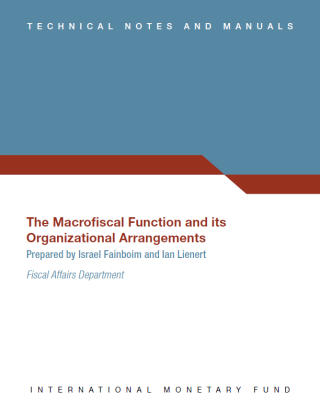
Posted by Israel Fainboim and Ian Lienert[1]
Conducting sound fiscal policy requires a strategic vision that anchors the annual budget in a medium-term perspective. Whatever the level of a country’s development, the ministry of finance (MoF) needs a department or unit with strong macro-fiscal analytical capacity. A new (TNM) provides guidance for strengthening this critically important function which underpins good fiscal policy and budget systems.
The medium-term macro-fiscal framework has become a key fiscal policy tool, as it provides the overall context under which sustainable fiscal targets are set, policy choices are determined, and realistic revenue and expenditure projections are prepared.
The new TNM examines the key tasks and organizational features of a Macro-Fiscal Department (MFD). It begins by defining the macro-fiscal function as the preparation of the framework needed to attain fiscal and debt sustainability objectives, with due recognition of fiscal risks.
The number and sophistication of the outputs of the MFD has grown over time. These outputs include the following:
- A medium-term fiscal strategy document (MTFF), including medium-tem macroeconomic and fiscal projections.
- The macro-fiscal strategy and policy priorities for the annual budget (typically updated with a mid-year review of the medium-term strategy and projections).
- A fiscal risk statement.
- Debt sustainability analysis (DSA).
- A report on compliance with fiscal rules, should such rules be in place.
- In-year economic and fiscal reports.
- Long-term fiscal projections (20-50 years).
There is no single “model” for the positioning of macro-fiscal responsibilities within the finance ministry’s overall organizational structure. Countries have adopted a range of approaches which include:
- A single department in the MoF that performs all major macro-fiscal functions.
- Several departments of the MoF that perform macro-fiscal functions collaboratively.
- An approach in which the finance ministry shares macro-fiscal functions with another ministry, for example the ministry of planning or the ministry of economic affairs. In several countries, a ministry of planning prepares the investment budget as well as, in some cases, preparing the macroeconomic forecasts.
There are tradeoffs between focusing all macro-fiscal functions in one MoF department and dispersing them across several MoF departments and/or other government agencies. A “concentrated” MFD that performs all, or nearly all, macro-fiscal functions minimizes potential inconsistencies in technical work and fiscal policy analysis, and reduces coordination costs. On the other hand, assigning certain specialized fiscal functions, e.g., tax policy analysis and the evaluation of specific fiscal risks, to other units may result in better technical analysis.
There is also no single model for the MFD’s internal structure. For the purposes of illustration, the TNM proposes a possible three-division MFD, comprising:
- A Macroeconomic and Fiscal Forecasting Division;
- A Fiscal Policy Division; and
- A Structural Fiscal Policy and Risk Analysis Division (Risk Analysis could constitute a fourth division)
The TNM briefly examines the various models used for fiscal policy analysis, and macroeconomic and fiscal forecasting. These range from “sophisticated” to “basic”. The TNM cautions against developing elaborate forecasting models. A first priority is to ensure that the MoF performs its core macro-fiscal tasks. As human and technical capacity is developed, macroeconomic and fiscal modeling can be enhanced.
The TNM stresses that the MFD is a key department of the MoF, on a par with other major departments such as Budget, Debt Management, and the Treasury. As such, it needs staff with strong analytical and communication skills, coupled with knowledge of modeling and forecasting techniques and information technology systems. The availability of skilled staff depends on adequate recruitment, remuneration, promotion, and retention policies. When macro-fiscal modeling in the MoF is underdeveloped, the MFD’s staff could avail themselves of the expertise developed in central banks and other organizations. IT systems for data collection and processing are required to facilitate the MFD’s work.
In summary, this TNM fills an important gap in the literature. It is expected that the paper will provide useful guidance for strengthening macro-fiscal functions of MoFs in many developing countries and emerging markets.
[1] The authors are former staff members of the Fiscal Affairs Department, IMF.
Note: The posts on the IMF PFM Blog should not be reported as representing the views of the IMF. The views expressed are those of the authors and do not necessarily represent those of the IMF or IMF policy.







